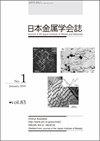Decrease of Concentration Boundary Layer Thickness by Using Vibrating Electromagnetic Force
IF 0.4
4区 材料科学
Q4 METALLURGY & METALLURGICAL ENGINEERING
引用次数: 2
Abstract
For clarification of vibrating electromagnetic force effect on concentration boundary layer thickness formed near solid–liquid interface, a metal copper working as an anodic electrode was dissolved into an electrolyte aqueous solution under the imposition of a vibrating electromagnetic force. For its excitation, a current composed of DC and AC components and a static magnetic field were simultaneously imposed on an electrolyte aqueous solution. Because the copper divalent ions concentration is related with brightness of the solution by Lambert–Beer law, brightness of the recorded data using a video camera was directly used for evaluation of the concentration boundary layer thickness formed near the anodic electrode. The concentration boundary layer thicknesses formed under the imposition of the DC current and the static magnetic field, under the imposition of the DC & AC superimposing current without a static magnetic field, and under the imposition of the DC current without a static magnetic field were almost the same, while that formed under the imposition of the DC & AC superimposing current and the static magnetic field was thinner in comparison with the other three conditions. Hydrodynamic instability induced by the vibrating electromagnetic force through a large velocity gradient when the DC & AC superimposing current and the static magnetic field were imposed on the solution might be the reason of the thinner concentration boundary layer. This might be a new tool for controlling mass transfer rate in a concentration boundary layer. [doi:10.2320/jinstmet.J2017022]振动电磁力降低浓度边界层厚度的研究
为了阐明振动电磁力对固液界面附近形成的浓度边界层厚度的影响,在振动电磁力的作用下,将金属铜作为阳极电极溶解在电解质水溶液中。它的激励是在电解液水溶液上同时施加直流和交流分量组成的电流和静态磁场。由于铜二价离子浓度与溶液亮度根据兰伯特-比尔定律相关,因此直接利用摄像机记录数据的亮度来评价阳极电极附近形成的浓度边界层厚度。施加直流电流和静磁场、施加交直流叠加电流而不施加静磁场和施加直流电流而不施加静磁场时形成的浓度边界层厚度几乎相同,而施加交直流叠加电流和静磁场时形成的浓度边界层厚度比其他三种情况要薄。在交直流叠加电流和静磁场作用下,振动电磁力通过较大的速度梯度引起的流体动力失稳可能是溶液浓度边界层变薄的原因。这可能是一种控制浓度边界层传质速率的新工具。(doi: 10.2320 / jinstmet.J2017022)
本文章由计算机程序翻译,如有差异,请以英文原文为准。
求助全文
约1分钟内获得全文
求助全文
来源期刊

Journal of The Japan Institute of Metals
工程技术-冶金工程
CiteScore
0.70
自引率
0.00%
发文量
27
审稿时长
6-12 weeks
期刊介绍:
Information not localized
 求助内容:
求助内容: 应助结果提醒方式:
应助结果提醒方式:


